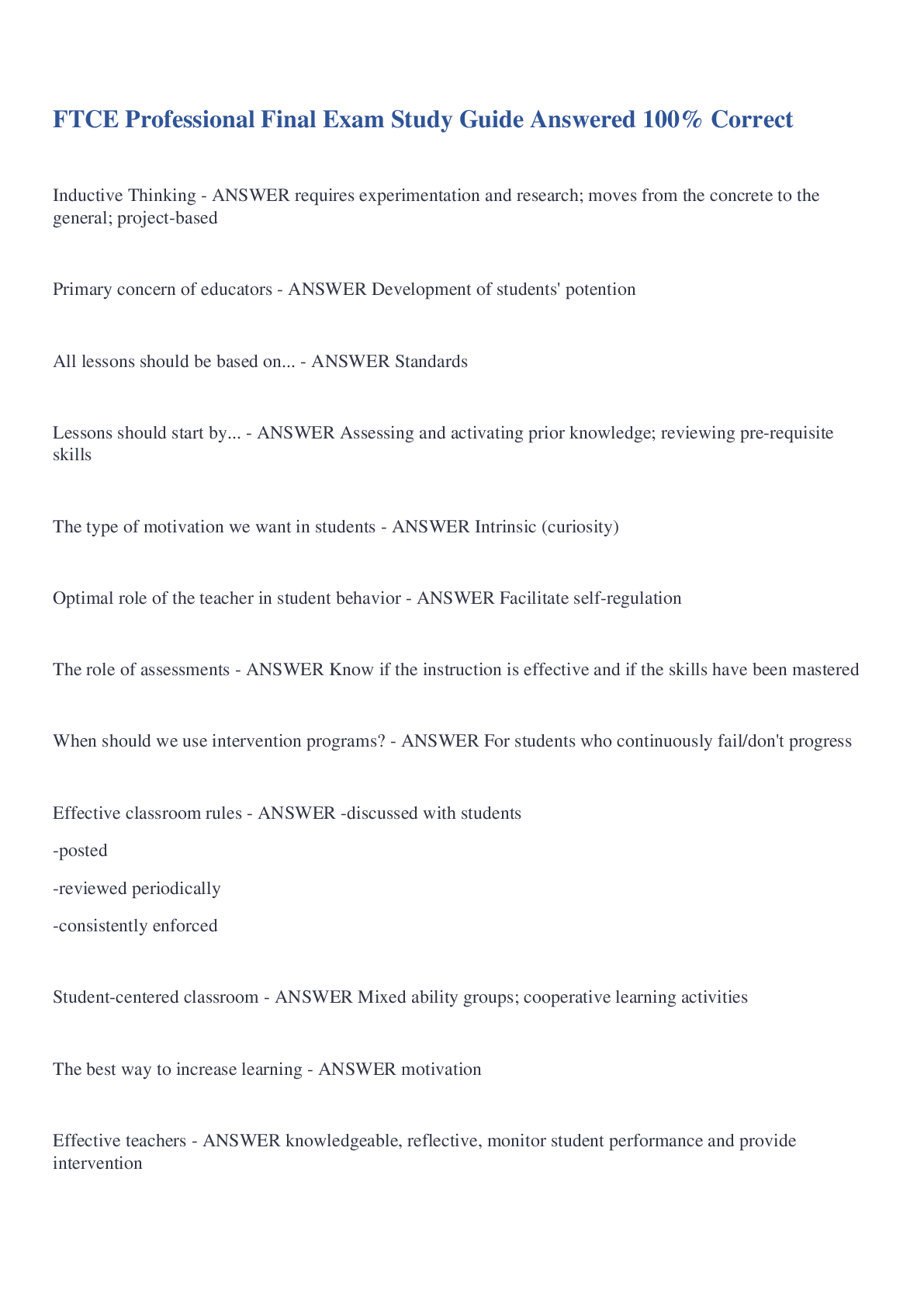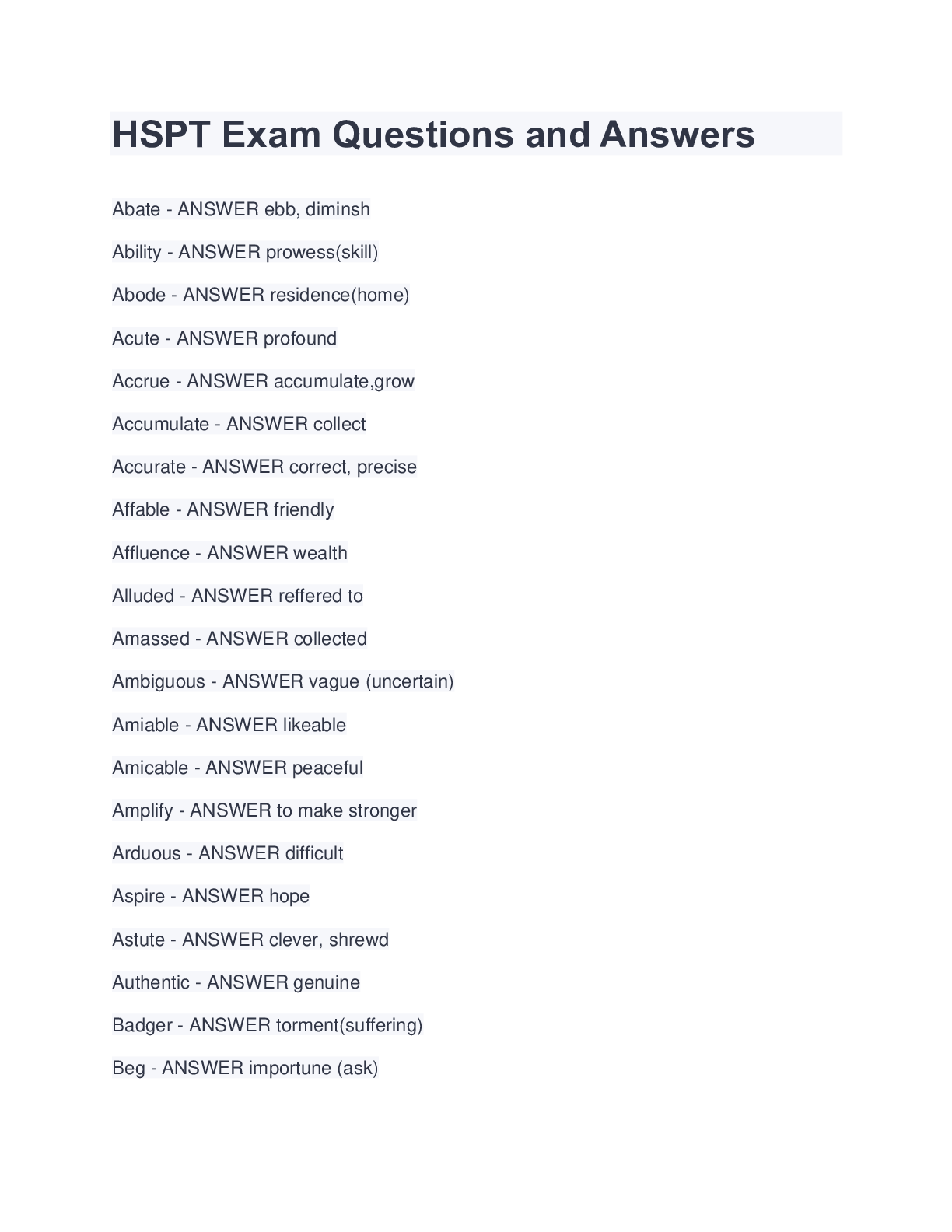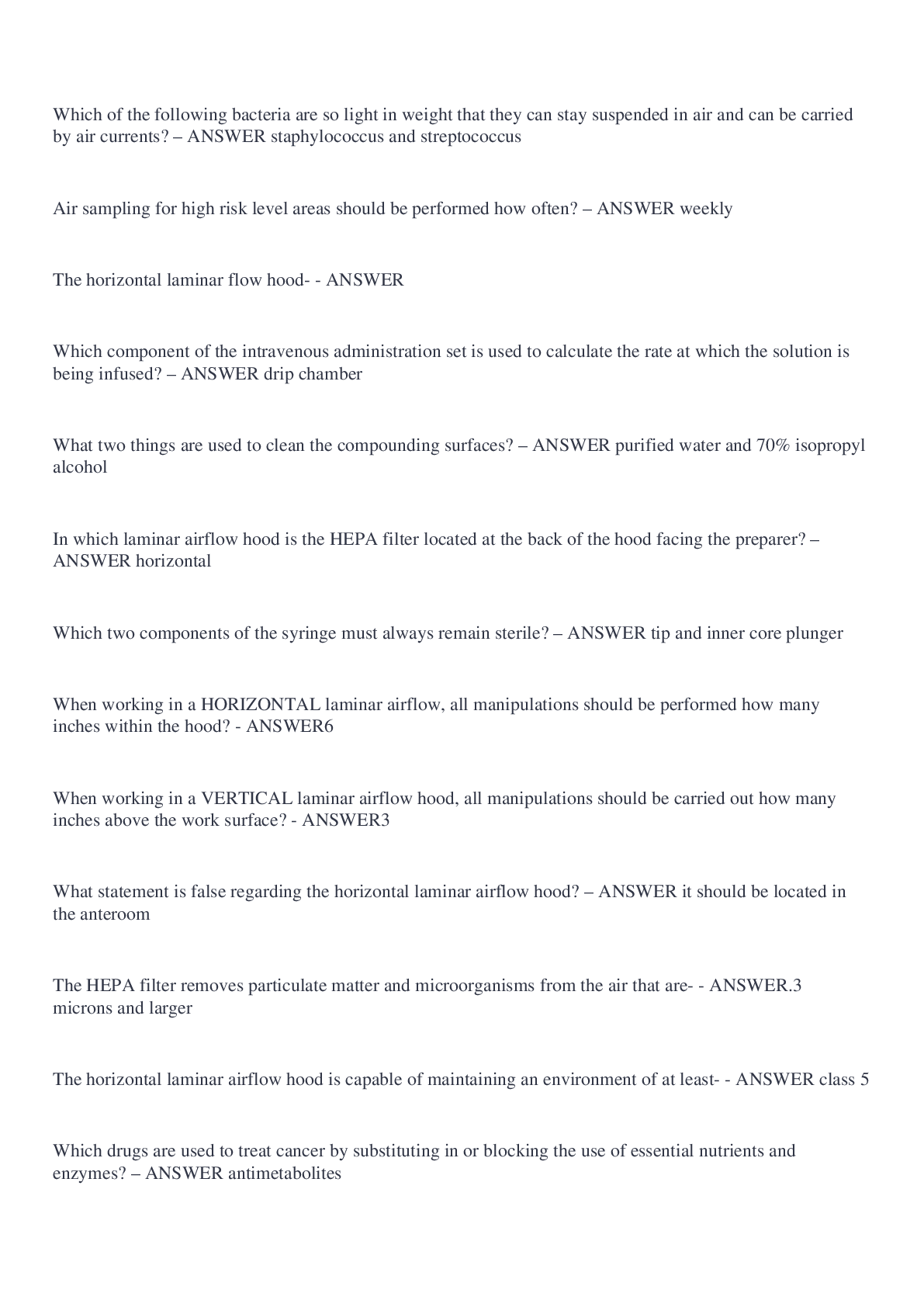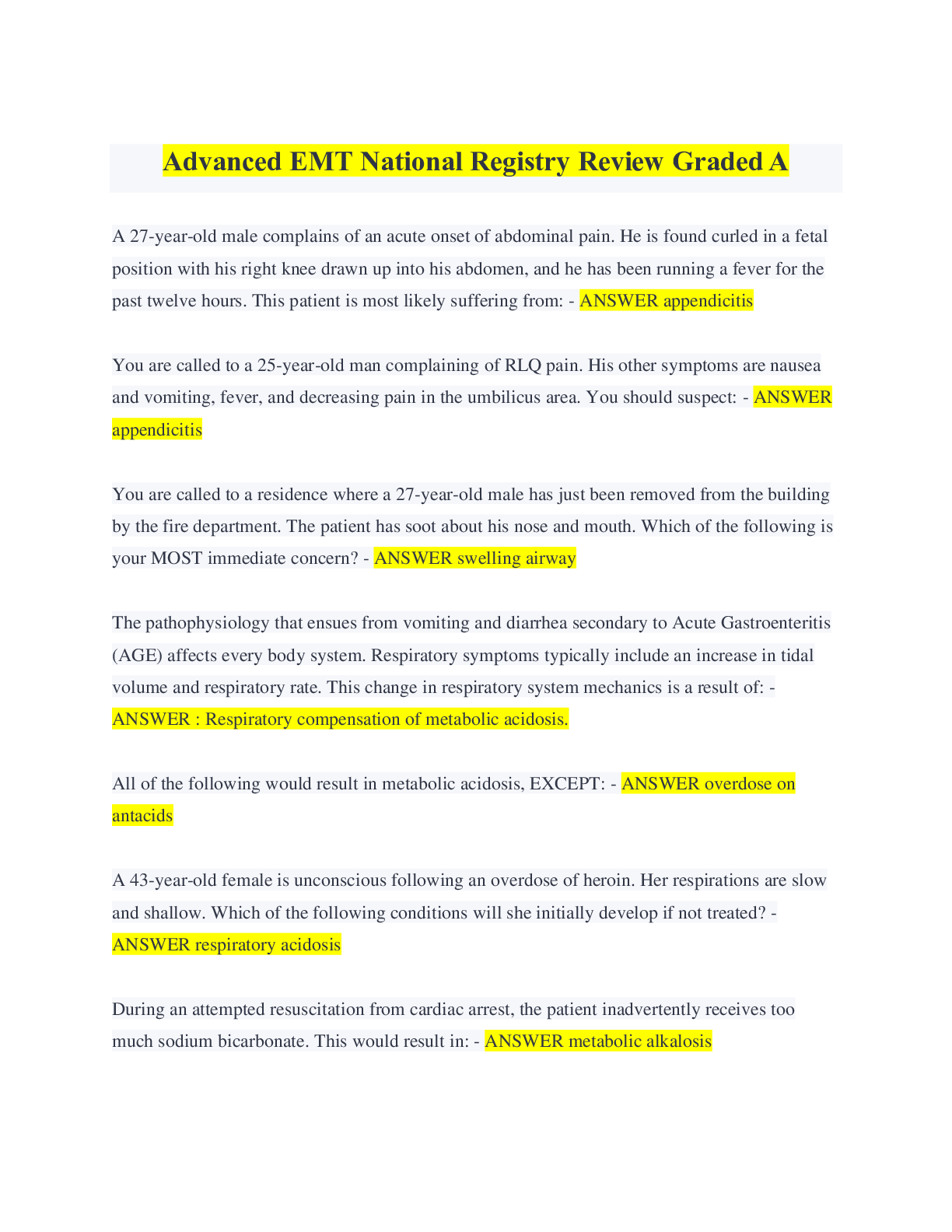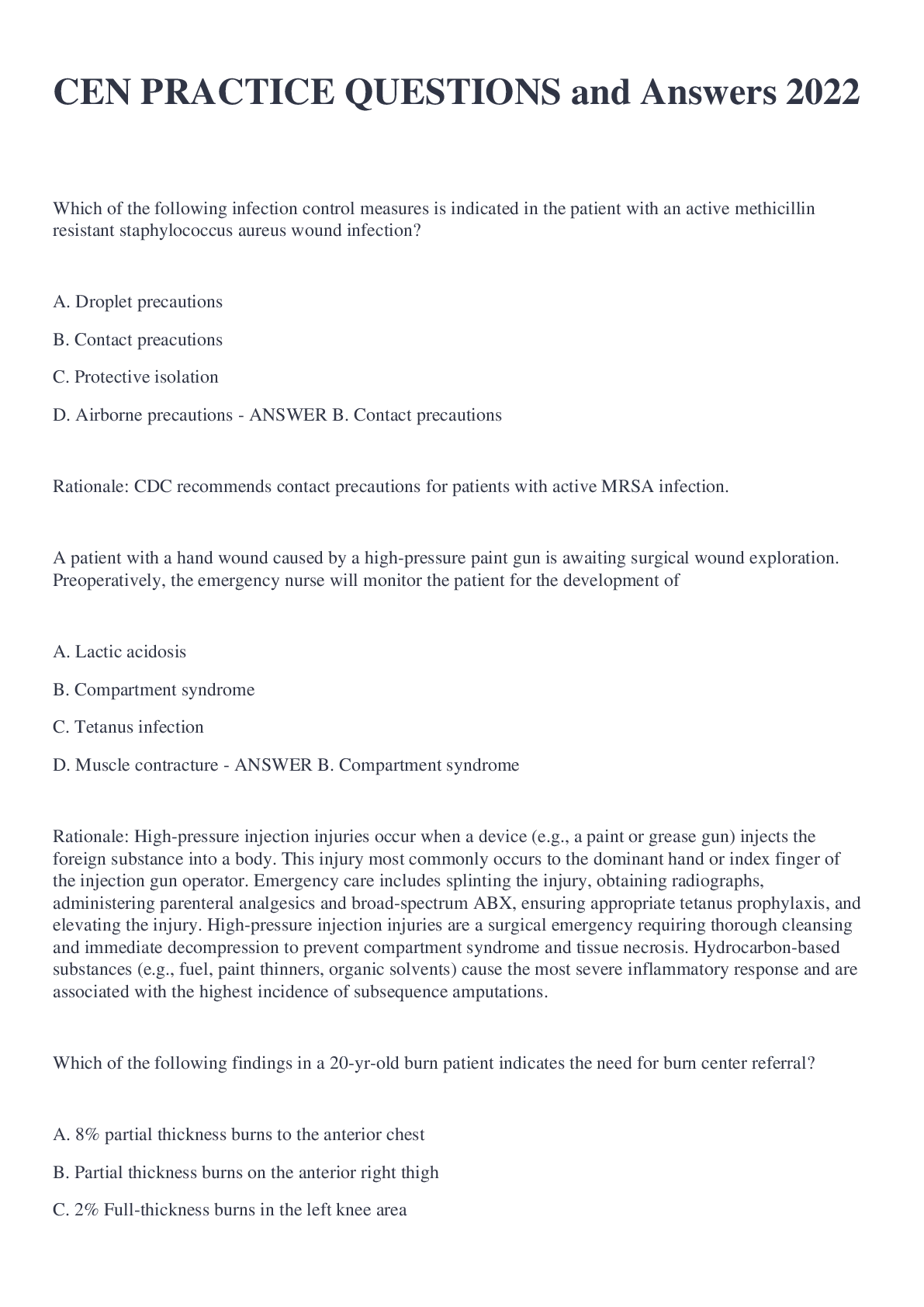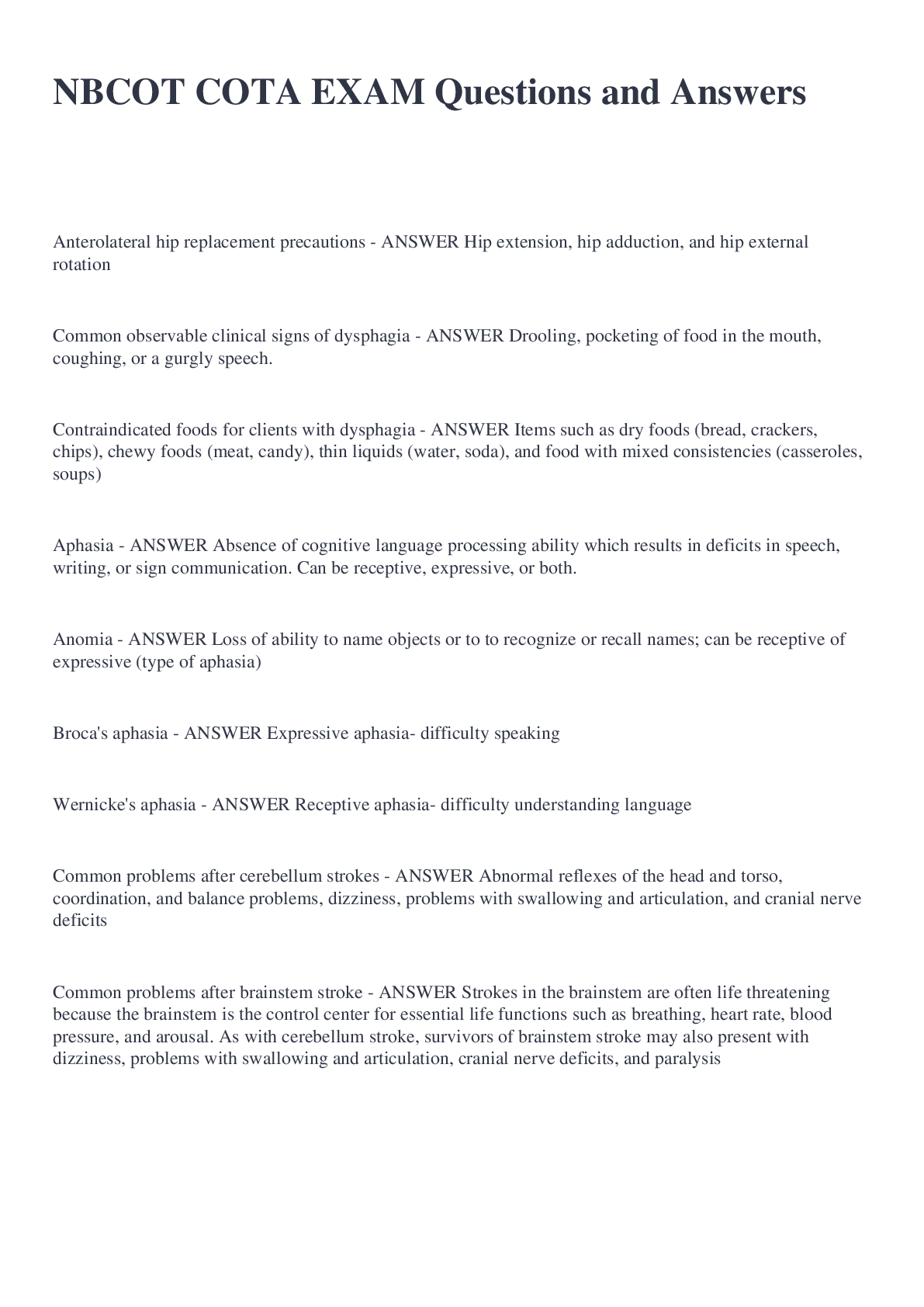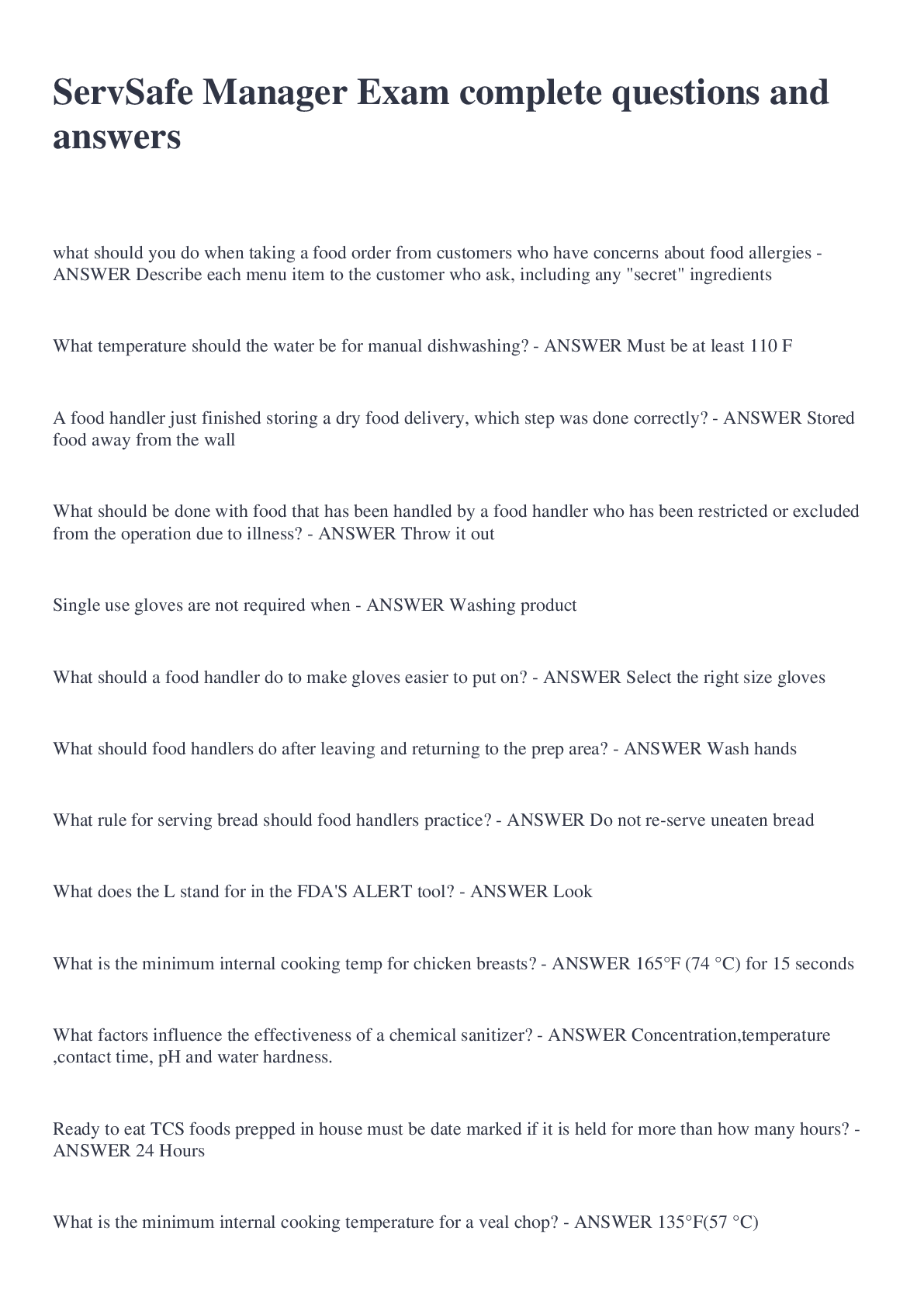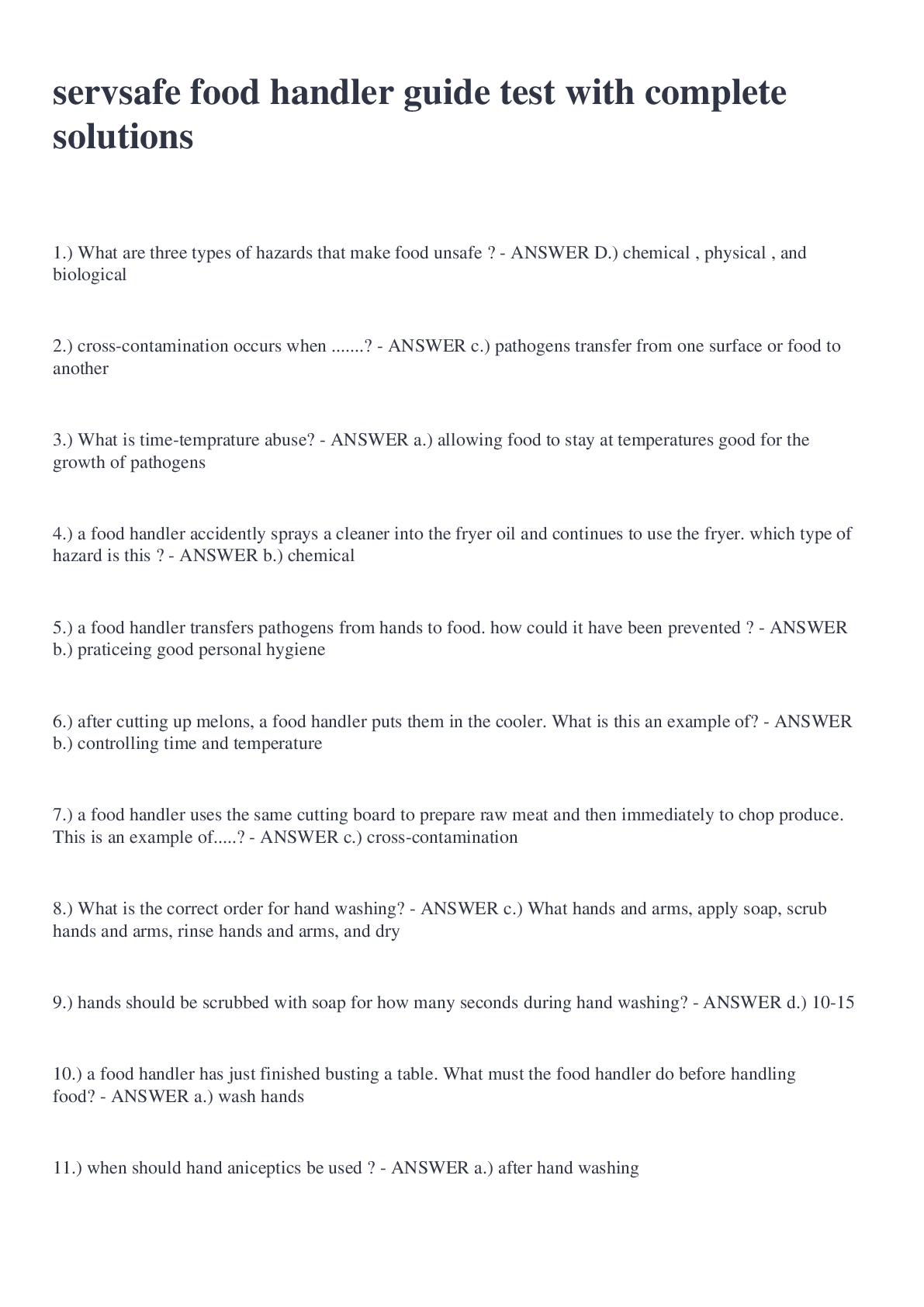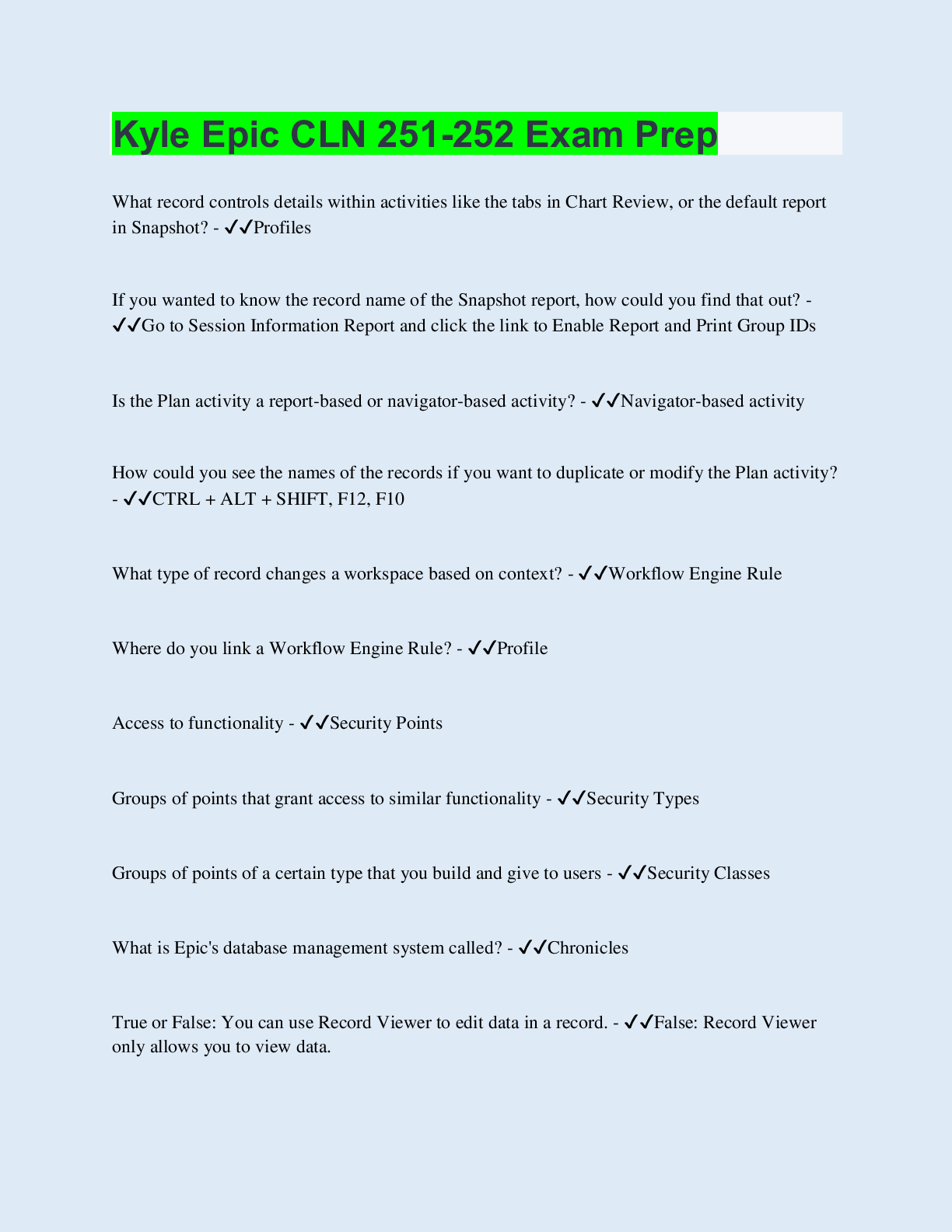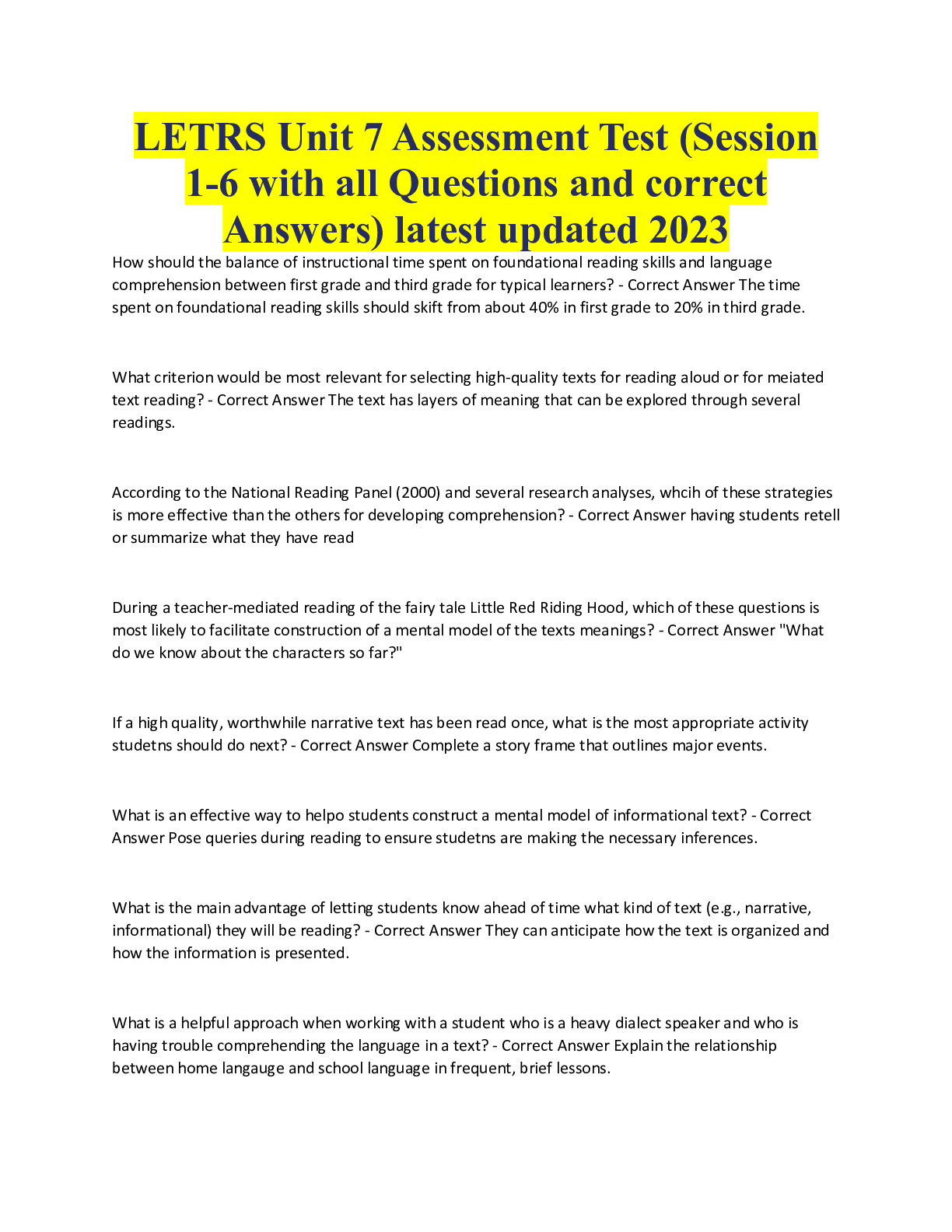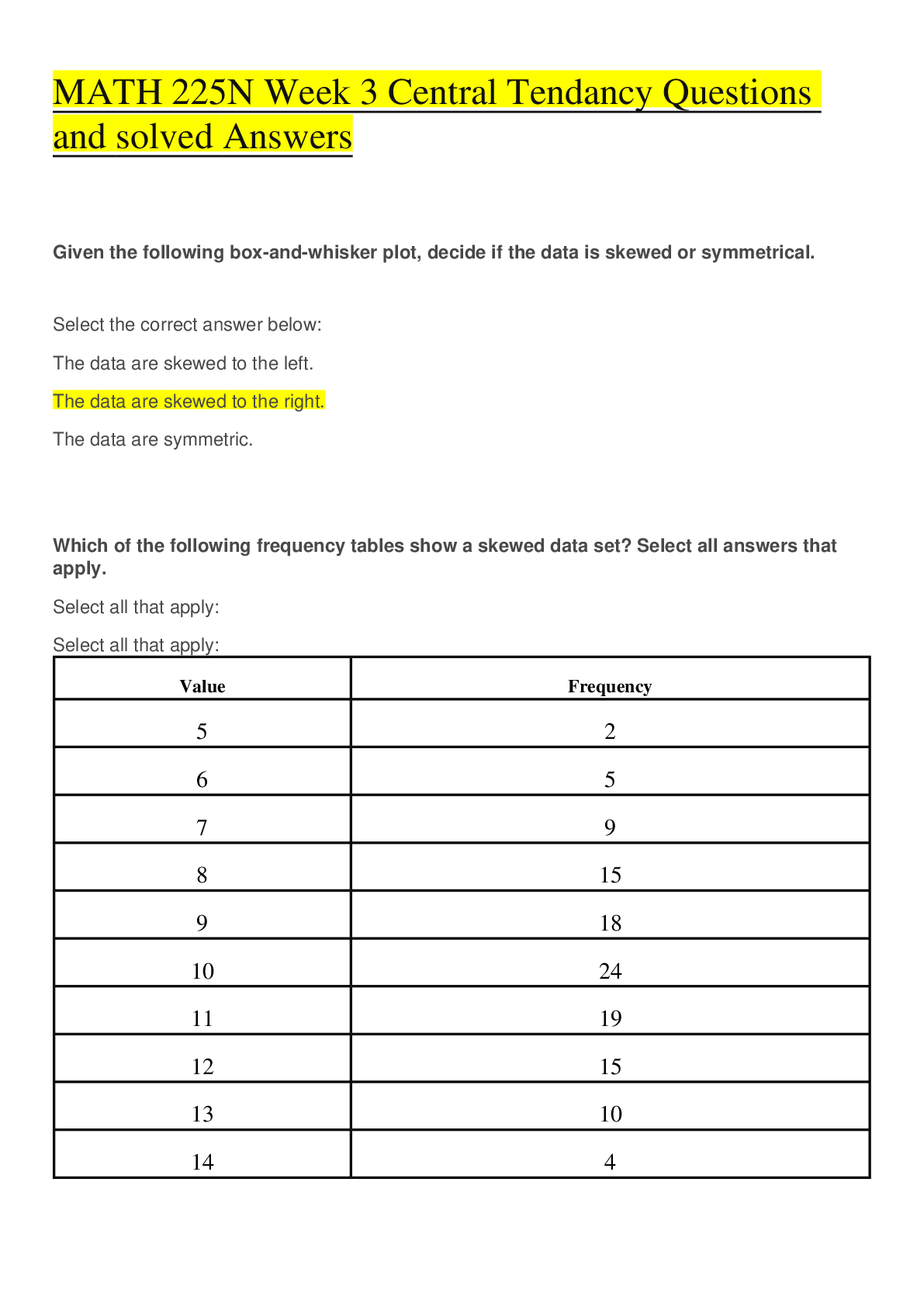Health Care > EXAM > Trauma – Fisdap Questions and Answers 100% correct (All)
Trauma – Fisdap Questions and Answers 100% correct
Document Content and Description Below
You arrive on the scene of a patient who fell from a ladder. Which of the following information is NOT an important factor in care of the patient? a)Height of the ladder b)Distance the patient fell ... from c)Surface the patient landed on d)What part of the body hit first - ANSWER a)Height of the ladder You are at the scene of an MVA, in which there are three patients, all of which have minor visible injuries. Two are refusing treatment and the last is complaining of neck and back pain. How should you proceed? a)Treat all three patients, they are visibly injured and need medical attention b)Obtain signed refusals from the first two patients then proceed to the third c)Treat the third patient, nothing else is needed for the other two d)Have your partner obtain refusals from the two patients who refused treatment, while you treat the last patient. - ANSWER d)Have your partner obtain refusals from the two patients who refused treatment, while you treat the last patient. Your patient is a 17 year old male found face down in a swimming pool. He is currently being held face up at the surface of the water. He is unconscious but breathing and has a pulse. What is the best course of action for this patient? a)Jump into the pool and begin CPR b)Remove the patient from the pool, immobilize, and transport. c)Apply cervical and spinal immobilization while the patient is still in the pool d)Wait for a trained water rescue team - ANSWER c)Apply cervical and spinal immobilization while the patient is still in the pool A laceration, spurting bright laceration, spurting bright red blood, most likely means what type of injury? what red blood most likely means a)Venous b)Arterial c)Capillary d)Amputation - ANSWER b)Arterial Your patient has a laceration to the right leg which has intersected the femoral artery. You have applied direct pressure to the wound, but it continues to soak through the bandages. What should you do next? a)Apply a tourniquet b)Elevate the leg c)Remove the old bandage and apply new ones d)Apply pressure to point just above the injury - ANSWER b)Elevate the leg Of the two types of energy, which type of energy transfer in a motor vehicle crash (MVC) with frontal impact, non-restrained driver with bent steering wheel, and spidered windshield? a)High velocity penetrating b)Decelerating c)Low velocity penetrating d)Blunt - ANSWER d)Blunt Any penetrating missile traveling over 2,000 ft/sec would be classified as? a)Low velocity b)Medium velocity c)High velocity d)Decelerating - ANSWER c)High velocity When there is penetrating trauma there is a permanent cavity which is formed by the projectile contacting the tissues. How is a temporary cavity formed? a)By the twisting of the projectile b)By energy scrubbing off of the projectile c)The wadding entering the body d)Unspent gun powder - ANSWER b)By energy scrubbing off of the projectile The way a patient is injured is often referred to as the _______________? a)Mechanism of injury b)Nature of illness c)Injury pattern d)Energy transfer - ANSWER a)Mechanism of injury When approaching a scene of trauma incident, what is your first order of business? a)Airway b)C-Spine control c)Body substance Isolation d)Scene safety - ANSWER d)Scene safety A large collection of blood under the skin is known as? a)Contusion b)Abrasion c)Hematoma d)Bruise - ANSWER c)Hematoma Your trauma patient has her left hand caught between rollers on a conveyor belt. Extrication takes 30 minutes. Evaluation of the injury during extrication showed delayed capillary refill distal to the injury. Post extrication shows rapid capillary refill distal to the injury deformity mid-palm. There are no obvious fractures, no lacerations, and minor swelling. Knowing that crush injuries can cause many other problems, which is NOT considered a crush injury complication? a)Compression of tissues b)Fractures c)No injury at all d)Compartment syndrome - ANSWER c)No injury at all Loss of tissue in a traumatic event can be: just soft tissue, a portion of an extremity, or an entire extremity. If your patient has lost the distal one-third of a lower extremity, what would that injury be called? a)Amplitude b)Avulsion c)Extremity exodus d)Amputation - ANSWER d)Amputation In any traumatic event where there is tissue damage that caused bleeding, the bleeding needs to be controlled. What are the proper steps to bleeding control? a)Direct pressure, elevation, tourniquet, digital pressure b)Direct pressure, digital pressure, elevation, tourniquet c)Tourniquet, elevation, pressure dressing, direct pressure d)Direct pressure, pressure dressing, tourniquet - ANSWER b)Direct pressure, digital pressure, elevation, tourniquet Your 16 year old trauma patient has what appears to be a mid-shaft femur fracture. You notice that there is a laceration directly over the suspected fracture. Bleeding is controlled. What type of fracture would this be? a)Greenstick b)Comminuted c)Closed d)Open - ANSWER d)Open En route to the hospital, you intubate the patient. During your assessment of tube placement, you hear wheezing in the upper lung fields. What is most likely causing this wheezing? a)Inhalation injury to the upper airway b)Inhalation induced cardiac wheezing c)Inhalation induced asthma attack d)Inhalation injury to the lower airway - ANSWER d)Inhalation injury to the lower airway Following the immobilization of an extremity fracture to the lower right arm, the paramedic should perform what step last? a)Ensuring the splint is applied tightly. b)Placing the hand in the position of function. c)Assessing presence of distal motor, sensory, and perfusion. d)Placing the immobilized extremity below the level of the heart - ANSWER c)Assessing presence of distal motor, sensory, and perfusion. You are treating a 24-year-old female with a gunshot wound to the right side of the back. No exit wound is visible. She is awake but confused. Her skin is pale and diaphoretic with cyanosis noted to the oral mucosa. Breath sounds are clear and equal bilaterally. Jugular vein distention is present. Blood pressure is 90/78 mmHg, heart rate is 124 beats per minute, and respiratory rate is 28 per minute and labored. Sinus tachycardia is seen on the cardiac monitor. What condition do you think is most likely present with this patient? a)Hemothorax b)Tension pneumothorax c)Pericardial tamponade d)Lacerated aorta - ANSWER c)Pericardial tamponade You are treating a 24-year-old female with a gunshot wound to the right side of the back. No exit wound is visible. She is awake but confused. Her skin is pale and diaphoretic with cyanosis noted to the oral mucosa. Breath sounds are clear and equal bilaterally. Jugular vein distention is present. Blood pressure is 90/78 mmHg, heart rate is 124 beats per minute, and respiratory rate is 28 per minute and labored. Sinus tachycardia is seen on the cardiac monitor. Which of the following treatment regimens would be the most appropriate for this patient? a)High flow oxygen, spinal precautions, occlusive dressing over entrance wound, rapid transport. b)High flow oxygen by nonrebreather, spinal precautions, allow patient to remain in a position of comfort. c)High flow oxygen by nonrebreather, cover entrance wound with an occlusive dressing. d)High flow oxygen, pleural decompression to right side of chest, rapid transport. - ANSWER a)High flow oxygen, spinal precautions, occlusive dressing over entrance wound, rapid transport. You are treating a 12-year-old male patient who was hit in the nose with a baseball. His nose is deviated to the left with moderate epistaxis. He is complaining of severe pain to his nose. He is alert and oriented with no loss of consciousness. Which of the following treatment sequences would best manage this patient? a)Pack nares with gauze to control bleeding. b)Have patient lie supine while holding pressure to nares. c)Align nose in the neutral position while holding pressure to nares. d)Have patient sit upright and lean forward while holding pressure to nares. - ANSWER d)Have patient sit upright and lean forward while holding pressure to nares. You are called for an elderly female that fell down and hurt her knee. When you find the patient, she tells you she tripped and fell, and landed on her left knee. She denies any loss of consciousness or trauma to her head. The patient is only complaining of pain to the distal portion of her femur. During your assessment, you notice deformity and swelling to the femur, proximal to the knee. The patient has good distal pulses, motor function, and sensation. What would be the most appropriate treatment for this patient? a)Secure to a backboard and pad appropriately b)Application of padded board splints c)Traction splinting d)Inflation of the PASG on both legs - ANSWER a)Secure to a backboard and pad appropriately Which of the following patients would be most appropriate for triage to a non-trauma center? a)67-year-old female who was electrocuted by a 220 volt electrical outlet b)19-year-old male involved in a single car MVC at a rate of 25 miles per hour c)25-year-old female with a 1-inch laceration on her thigh d)14-year-old male who fell 11 feet out of a tree, landing on his back - ANSWER c)25-year-old female with a 1-inch laceration on her thigh You have responded to a local residence of a 37-year-old male who had lacerated his leg while using a chainsaw in the back of his house. Prior to your arrival, the patient's wife, who is a nurse, applied pressure to the wound and has the patient in a Trendelenburg position. Your assessment of the patient reveals him to be responsive to painful stimuli with a weak carotid pulse and the blood pressure unobtainable. There is a massive amount of blood surrounding the patient on the ground. The wife tells you that the wound is arterial and the injury occurred about 10 to 15 minutes ago. In addition to oxygen therapy, what are your treatment priorities for this patient? a)Continue applying direct pressure to the wound and call for ALS support. b)Apply an arterial tourniquet and call for ALS support. c)Apply an arterial tourniquet and call for ALS support. d)Continue applying direct pressure to the wound and transport. - ANSWER a)Continue applying direct pressure to the wound and call for ALS support. Which of the following findings in a crush injury is typically the earliest and most prominent? a)Pain b)Pulselessness c)Paresthesia d)Paralysis - ANSWER a)Pain Your 26-year-old female patient has been pulled out of a house fire. Her chest and arms have been burned. The area is charred and the patient states she has little pain in the burned area. What is the most likely classification of this patient's burns? a)Full thickness b)Superficial partial thickness burns c)Deep partial thickness burns d)Superficial - ANSWER a)Full thickness You have responded for a 43-year-old male who was involved in an altercation. The patient was reportedly beaten about the face and head with a baseball bat. The patient is unresponsive. Evaluation of the patient's face reveals instability from the orbits to the mandible. Based on this information, how would you definitively manage this patient's airway? a)Immediately assist ventilations with a Bag-Valve-Mask. b)Orally intubate the patient and assist ventilations with a Bag-Valve-Mask. c)Insert an oral airway and assist ventilations with a Bag-Valve-Mask. d)Insert a nasal airway and assist ventilations with a Bag-Valve-Mask. - ANSWER b)Orally intubate the patient and assist ventilations with a Bag-Valve-Mask. When managing an open fracture, you should do which of the following? a)Cover the exposed bone ends with a moist sterile dressing. b)Provide mild manual traction to restore distal circulation. c)Leave the wound exposed if there is no massive bleeding from the area. d)Apply a pressure dressing to prevent blood loss. - ANSWER a)Cover the exposed bone ends with a moist sterile dressing. What is the most common spinal injury associated with improper lifting techniques? a)Thoracic b)Cervical c)Lumbar d)Sacral - ANSWER c)Lumbar You respond to the scene of a residential natural gas explosion to find a 36-year-old male patient complaining of a diminished ability to hear, moderate dyspnea, and acute abdominal pain. These symptoms are likely due to what mechanism? a)Primary blast injury b)Secondary blast injury c)Tertiary blast injury d)Toxic inhalation of natural gas - ANSWER a)Primary blast injury While assessing the carotid and radial pulse in your unresponsive patient, you determine that the carotid pulse is weak and rapid, and the peripheral pulses are absent. What other clinical assessment finding would you expect to be present? a)An irregular rhythm of the pulse b)A decrease in the respiratory rate c)Cool and pale skin d)An increase in arterial pressure - ANSWER c)Cool and pale skin Your patient is suffering from Epistaxis. How should you proceed. a)There is no treatment for Epistaxis b)Pack the area with gauze c)Pinch the nostrils and have the patient lean forward d)Pinch the nostrils and have the patient tilt their head backwards - ANSWER c)Pinch the nostrils and have the patient lean forward What are the signs and symptoms of shock a)Increased heart rate, increased respirations, hypotension b)Decreased heart rate, increased respirations, hypotension c)Increased heart rate, decreased respirations, hypertension d)Decreased heart rate, increased respirations, hypertension - ANSWER a)Increased heart rate, increased respirations, hypotension Your patient is a 22 year old male with an object impaled in the right side of his chest, just below the shoulder. After assessing that the object is not blocking his airway, what is the best course of action for this patient? a)Remove the object by pushing it through the same direction as it entered b)Remove the object by pulling it back out the way it entered. c)Cut the object close to the patient in order to control the bleeding and transport the patient d)Stabilize the object in place, control the bleeding and transport - ANSWER d)Stabilize the object in place, control the bleeding and transport Your patient has an injury that consists of overstretched & torn ligaments. What type of injury does this patient have? a)Strain b)Sprain c)Fracture d)Dislocation - ANSWER b)Sprain What is the best treatment for a suspected fracture of the talus bone? a)Apply a traction splint, heat, and elevate the leg b)Apply a traction splint, ice, and elevate the arm c)Splint the ankle, apply ice, and elevate d)Splint the foot, apply heat, and elevate - ANSWER c)Splint the ankle, apply ice, and elevate When dealing with a patient who has suffered an injury to the back of his head, what part of the brain would you suspect will be affected? a)Frontal b)Occipital c)Parietal d)Temporal - ANSWER b)Occipital Your patient is a 34-year old male with a large laceration to the abdomen, and the abdominal organs are protruding from the wound. What is this type of injury called? a)Evisceration b)Avulsion c)Protrusion d)Contusion - ANSWER a)Evisceration What is the best way to handle an amputated extremity? a)Pack it in ice b)Wrap it in plastic and place on ice c)Wrap it in sterile dressings and keep it cool with ice d)Place it in a container filled with saline solution - ANSWER c)Wrap it in sterile dressings and keep it cool with ice You are transporting a trauma patient, and notice their condition starts to deteriorate. What do you do? a)Stop the ambulance and begin CPR b)Tell your partner to drive faster; you need to get this patient to the hospital now c)Reassess your patient d)Call medical control - ANSWER c)Reassess your patient You are transporting an unconscious patient. How often should you check their vitals? a)5 minutes b)2-3 minutes c)10 minutes d)15 minutes - ANSWER a)5 minutes What is the mnemonic for determining level of consciousness? a)OPQRST b)AVPU c)SAMPLE d)ABC - ANSWER b)AVPU Your patient is a 16-year old male, who fell approximately 15 feet. This call should be considered: a)Not a traumatic emergency b)A traumatic emergency, that requires airlifting the patient to the nearest level 1 trauma center c)A significant mechanism of injury d)Not a significant mechanism of injury - ANSWER d)Not a significant mechanism of injury A fall greater than ______ would be considered a significant mechanism of injury in a patient under the age of 8. a)The height of the patient b)5 feet c)Double the patient's height d)10 feet - ANSWER d)10 feet You are called to the scene of pedestrian that's been struck by a car. Upon examination, you notice clear fluid leaking from the patient's ear, that you believe to be cerebral spinal fluid. This tells you the patient may have suffered a: a)Severe head injury b)Basilar skull fracture c)Ruptured eardrum d)Cervical spine injury - ANSWER a)Severe head injury What does PMS stand for during your assessment of a patient's lower extremity? a)Pedial , Motion, Sensation b)Pain, Motion, Severity c)Pulse, Motor function, Sensation d)Pulse, Motor sensation, Severity - ANSWER c)Pulse, Motor function, Sensation A 34 year old male has a fractured left elbow, and his arm is cyanotic and pulseless. What should you do? a)Stabilize the elbow with a sling and swathe b)Immobilize the arm with a traction splint c)Align with gentle traction until resistance is met d)Immobilize the arm as it was found - ANSWER c)Align with gentle traction until resistance is met What is the term for the injury in which the epidermis remains intact, but cells and blood vessels in the dermis may be damaged? a)Contusion b)Evisceration c)Hematoma d)Avulsion - ANSWER a)Contusion A 41 year old male was kicked in the chest by a horse. He is short of breath and he has a contusion to his sternum. Vital signs are BP 96/78. P 124, and shallow. What should you suspect? a)Congestive heart failure b)Cardiac tamponade c)Pulmonary embolism d)Pulmonary edema - ANSWER b)Cardiac tamponade A 21 year old male is semi-conscious and lying kiddywampus at the bottom of 2 flights of stairs. What should you do? a)Perform a sternal rub b)Assess for distal pulses c)Open the airway with jaw thrust maneuver d)Manually stabilize c-spine - ANSWER d)Manually stabilize c-spine A 21 year old female has an open femur fracture after falling off a horse. What should you do? a)Check for a distal circulation b)Apply manual stabilization to her femur c)Apply a traction splint d)Immobilize her on a long back board - ANSWER b)Apply manual stabilization to her femur What is most life threatening for an adult patient? a)Bubbling wound to the chest b)Bowel evisceration c)Active bleeding from the forehead d)Compound tibia fracture - ANSWER a)Bubbling wound to the chest [Show More]
Last updated: 2 years ago
Preview 1 out of 32 pages
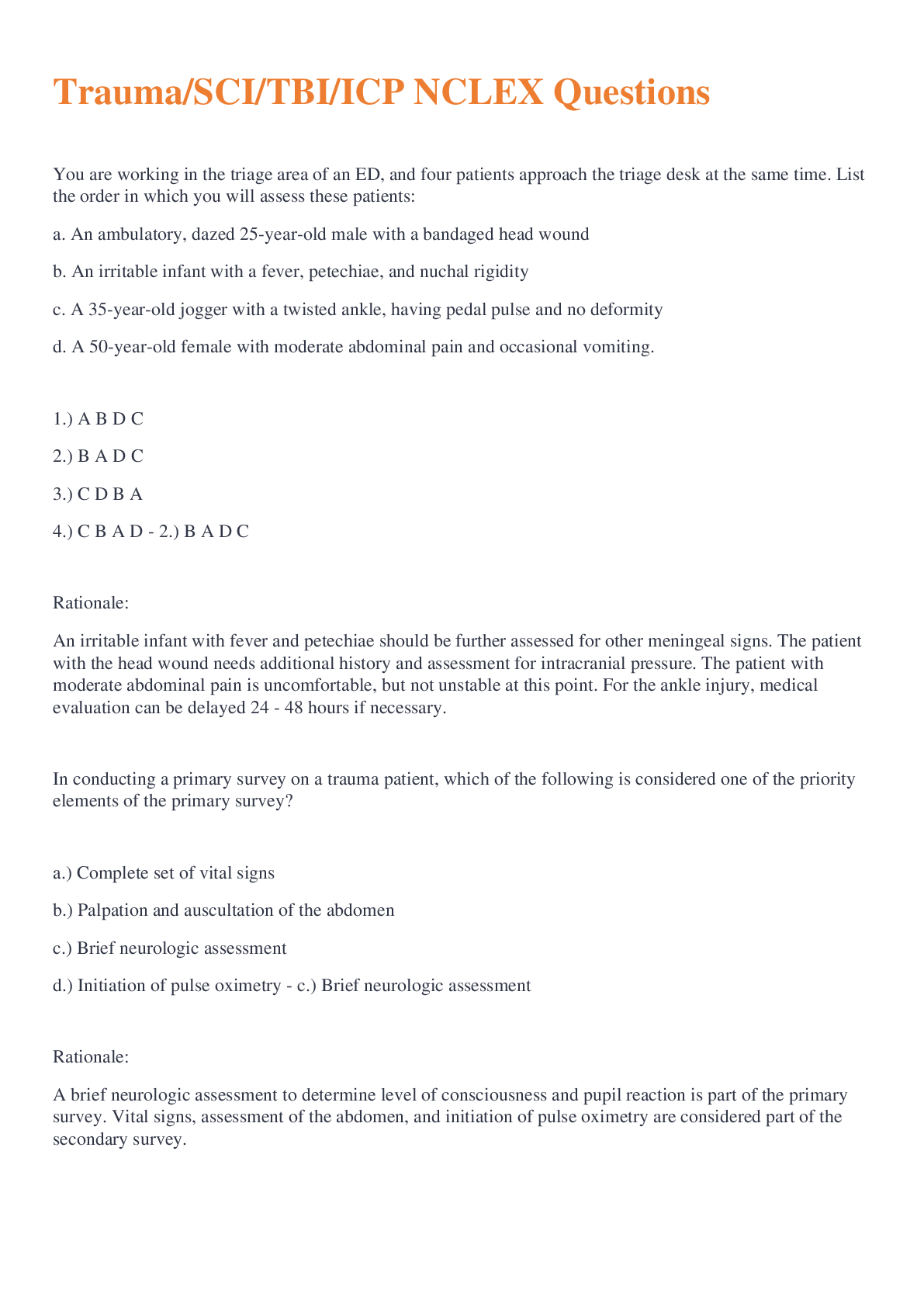
Buy this document to get the full access instantly
Instant Download Access after purchase
Buy NowInstant download
We Accept:

Reviews( 0 )
$10.00
Can't find what you want? Try our AI powered Search
Document information
Connected school, study & course
About the document
Uploaded On
Sep 01, 2022
Number of pages
32
Written in
Additional information
This document has been written for:
Uploaded
Sep 01, 2022
Downloads
0
Views
51


